At Hebrew Academy in Montreal, the students are chilling out – with the blessing of their teachers, who are kicking back, too.
With all the social, academic and personal stressors of modern life, it’s not easy being a kid these days. Recognizing that everyone could use a break from time to time, elementary school counsellor Shiri Benoualid and acting director of academic support services Karine Plouffe came up with an idea: what if Hebrew Academy created an inviting space where students could go to unwind and rejuvenate?
With administrative encouragement, a “sensory room” was created. Located in the cafeteria, it’s a cosy, dark space with a lounge chair, soft lights, dreamy music and tactile objects.
The concept of a sensory room to stimulate the senses and calm the nerves is not novel. Commonly used in geriatric, special needs and medical settings, the first Snoezelen rooms, as they are often called, were created in the Netherlands in the 1970s.
“There has been a lot of research on the benefits of such a space,” said Benoualid. “Typically, you can find them in hospitals, clinics, even airports. More recently, schools began to create them.…
“Sensory rooms enable students to regain control of their emotions, to gain awareness of their senses and well-being, to improve focus through the use of sensory equipment, to hone motor skills through movement and balance, and to learn how to process and cope in situations where their reactions may otherwise be extreme.”
It’s been found to be effective for kids who have a harder time self-regulating, or who are prone to feeling anxious, especially before a test or a presentation.
“It can also help them re-energize and increase their focus and motivation for learning,” she said.
While the room is full of fun objects, Benoualid emphasized that it is neither a playroom nor a lounge, but a therapeutic environment. All elementary students may visit the space one at a time, accompanied by an adult who is trained in its operation. They typically remain there between five and 20 minutes.
Hebrew Academy is considering extending the room to the high school.
The entire elementary resource staff is trained in how to use the room and the goal is for all teachers, assistants and support staff to learn how to use the space to its full advantage.
“As the school counsellor, I typically use my office as a confidential space to let kids talk and express their feelings,” said Benoualid. “But the calm room is an additional space to express emotions non-verbally.…
“Often, once the student has had a chance to explore the room, both by letting out some steam and then calming down and taking in the sensory stimulation, they disclose how they feel or what they felt before coming into the room.”
In the short while since the room has been open, the feedback has been overwhelmingly positive.
“Students who came into the sensory room with little energy reportedly returned to class re-energized and ready to learn. We also check in with students around how they are feeling as they enter the room and how they feel right before leaving,” she said. “So far, they have responded very positively, saying they feel more relaxed and calmer.”
